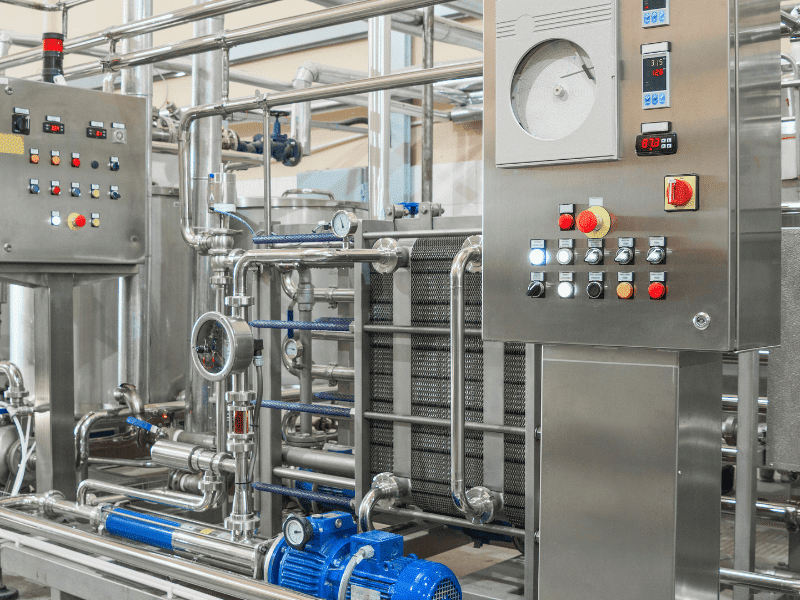With each passing day, data centers are becoming more advanced. Not only that, but they are also consuming more energy. According to a recent survey by Deloitte, data centers will consume about 2% of the world’s electricity in 2025. If converted into terawatt-hours, it is around 536 TWh. Similarly, this figure is expected to reach about 1065 TWh by 2030.
If not managed accordingly, this could also result in increased operational costs. Such massive consumption and cost could disrupt the overall infrastructure. So, data centers need to adopt significant thermal management techniques to lower consumption and cost. Today, we will discuss these techniques and their impact on data centers’ performance.
What is a Data Center?
A data center is a digital hub that stores, manages, and shares large amounts of data and applications. It includes computers, server machines, network machines, and storage devices. Data centers are behind every industry, including telecommunication, media, healthcare, AI, IT, education, and security. Modern technologies rely solely on data centers. Moreover, Private and Public departments prefer data centers to maintain their operations.
Core Features:
- Data centers are reliable for storing, processing, and delivering data.
- Data centers are reliable for smooth networking and connectivity.
- Data centers provide precision cooling and optimization.
- Data centers provide cybersecurity, including firewalls and data encryption.
- Data centers offer strong backup support if something unusual happens.
- Data centers enable tracking stats and performance parameters of the whole operation.
- Data centers are reliable, durable, and flexible.
Types of Data Centers:
Enterprise Data Centers:
- A type of data center owned by an individual/organization for relevant operations.
Colocation Data Centers:
- A type of data center where owners rent equipment to clients for relevant operations.
Cloud Data Centers:
- A type of data center managed by Google, Microsoft, and Amazon.
Edge Data Centers:
- A type of data center in the form of smaller hubs near the target users.
Why is Thermal Management Important for Data Centers?
As the data centers function continuously, they consume energy and produce massive amounts of heat. If this heat is not managed accordingly, it results in overheating and can cause internal damage to the components.
Not only that, but it also impacts performance negatively and reduces the life span of components. It results in increased maintenance and purchasing costs. So, implementing a proper thermal management strategy is very important.
- Avoids Overheating: Thermal management avoids overheating in data centers. It keeps the temperatures under the recommended degrees.
- Improved Performance: The controlled temperatures help data centers to perform at their best. When there is no throttling, no fluctuations occur.
- Improved Lifespan: Thermal management ensures an improved lifespan of data centers. Components operate smoothly without any extensive load.
- Reduces Energy Consumption: Controlled temperatures help data centers utilize an optimal energy load. This results in a reduced energy cost.
- Reduced Maintenance Cost: If data centers operate efficiently without overheating and performance drops. It helps to reduce maintenance costs.
Thermal Management Methods at Data Centers
1: Air-Cooling Method
Computer Room Air Conditioning (CRAC)
- CRAC functions like a traditional cooling system. It provides and circulates cool air to data centers. This method also maintains humidity levels under the recommended figures. If compared with other methods, this cooling method seems energy efficient.
Computer Room Air Handlers (CRAH)
- The CRAH method cools down the data centers by utilizing chilled water from chillers. It circulates the air to data centers efficiently and keeps the energy consumption as low as possible. Fans and Cooling Coils are also used in the CRAH method.
Hot and Cold Aisle Containment
- This cooling method is usually adopted for server machines. In this technique, server machines are placed in rows, hot air exhausts from the back side, and cold air enters from the front. Thus, the hot aisle is for hot air and the cold aisle for cold air.
Direct Chip Cooling
- The direct chip cooling method involves using heat sinks and fans. These are directly installed over the computing components. It is a more effective and cost-efficient method. Examples include CPUs, GPUs, and others.
2: Liquid-Cooling Method
Direct-to-Chip Cooling
- The liquid cooler’s cold plate is directly attached to the components. It dissipates the heat away from them and maintains a stable temperature level. Examples may include CPUs, GPUs, and other related components.
Immersion Cooling
- Immersion cooling is the most effective method of cooling data centers, especially computers. In this method, the components are directly dipped into a special liquid. The liquid has non-conductive features, so it cools down the components efficiently.
Rear Door Heat Exchangers
- In the rear door technique, liquid coolers are installed at the back of server machines. Usually, these are piping systems that contain circulating chilled water inside them. It effectively dissipates the heat before it enters the server machines.
3: Advanced Cooling Method
Phase-Change Method
- The phase change method is based on a process where a liquid form of cooling solution is attached to the component. When the component produces heat, the liquid changes its phase into a gas and then evaporates.
AI-Powered Method
- The AI-powered cooling method is based on machine learning. It is an automated process that monitors performance and temperature stats. Once learning is completed, it starts optimizing temperature and cooling adjustments.
Thermoelectric Method
- The Peltier Effect is applied in thermoelectric cooling. It is based on n-type and p-type semiconductors. Once voltage is applied, the n-type and p-type materials are activated to absorb hot air (heat sinks, liquid coolers) and release cold air (CPUs, GPUs).
4: Thermal Interface Materials Method
Thermal Paste
- A paste-like substance used on electronic components/devices to move heat and remove air gaps. Thermal paste is the most commonly used and affordable thermal interface material. It can be used in various data centers (CPUs, GPUs).
Thermal Pads
- The thermal pad is a flexible material used in electronic gadgets and devices to overcome heat and remove the microscopic gaps. It comes in various thicknesses and dimensions. Thermal pads are a reliable and affordable cooling solution in data centers.
Phase Change Materials
- PCMs are considered an advanced type of thermal interface material. This material functions by changing its phase from solid to liquid and vice versa. It is a solid solution that absorbs and releases heat from data center components.
JiuJu in this Regard
JiuJu is a reliable platform for buying quality TIMs and other cooling solutions. We have been in the thermal management industry for the last two decades. Our expertise includes manufacturing top-quality TIMs, Cooling, Bonding, and Leakage solutions.
We offer our products at wholesale rates and discounted offers to establish long-term business relationships with customers. So far, JiuJu has partnered with more than 500+ clients and is manufacturing tons of products every month.
Data Center owners can contact JiuJu for product counselling and quotations. Our customer support team is available 24/7 to help out the customers. So, overcome the energy consumption and cost of data centers by utilizing our products.
Concluding Remarks
We can’t deny the contribution of data centers in today’s times. Soon, the whole industry will rely on data centers to enhance their operations. Adopting a compatible thermal management solution is compulsory to improve performance and cost factors at data centers. Similarly, it also enhances the lifespan of components. Phase change materials, AI-driven, and air-cooling methods are reliable solutions to manage the thermal tasks at data centers.
JiuJu is here to help customers in choosing quality thermal interface materials. Check them out,





